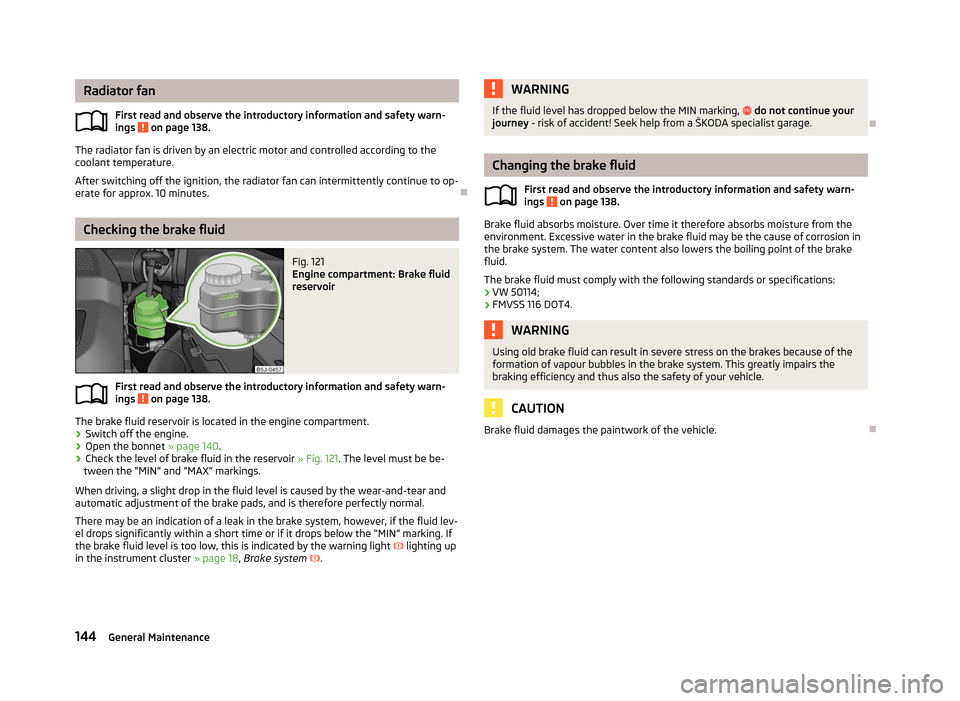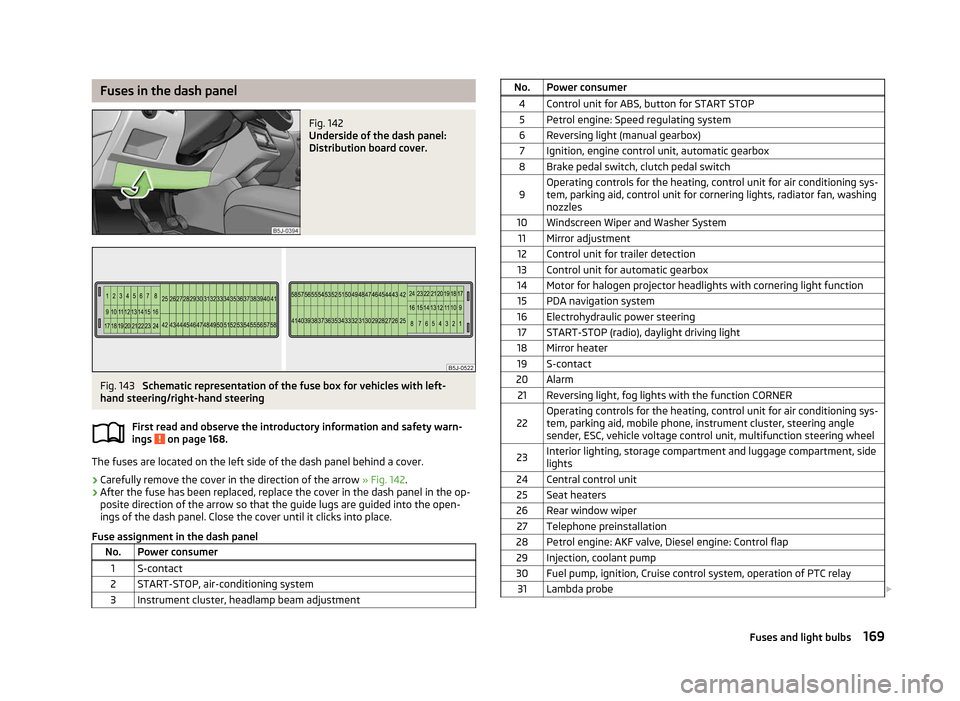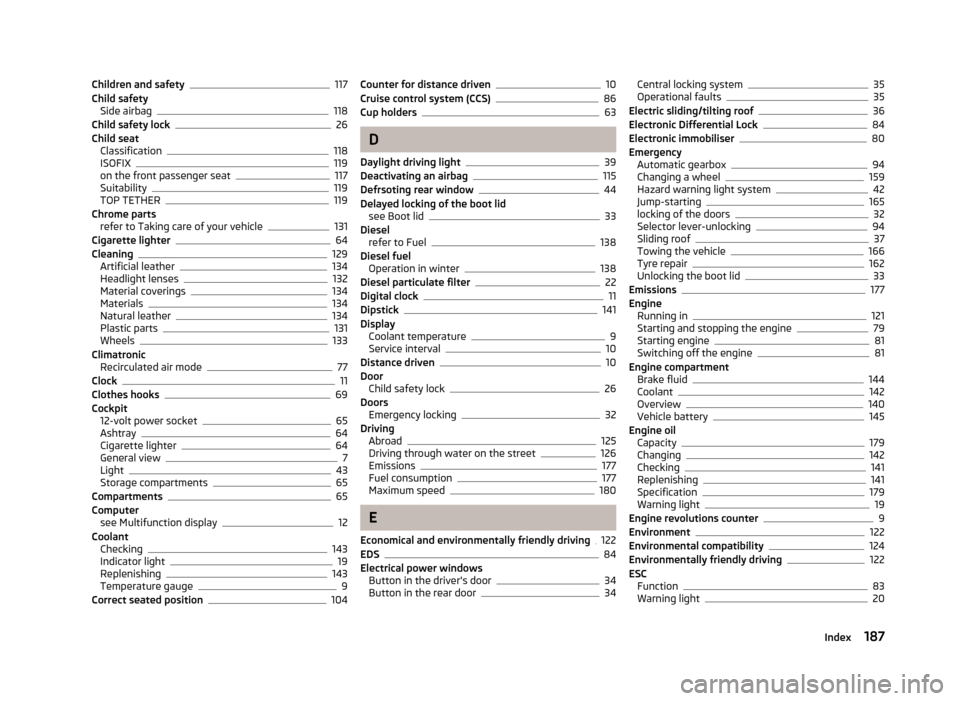engine coolant SKODA FABIA 2012 2.G / 5J User Guide
[x] Cancel search | Manufacturer: SKODA, Model Year: 2012, Model line: FABIA, Model: SKODA FABIA 2012 2.G / 5JPages: 196, PDF Size: 4.83 MB
Page 142 of 196

Opening and closing the bonnet
Fig. 116
Bonnet/radiator grille release lever: Release lever Fig. 117
Securing the bonnet with the
bonnet support
First read and observe the introductory information and safety warn-
ings on page 138.
Opening
›
Pull the release lever under the dash panel 1
» Fig. 116.
Before opening the bonnet, ensure that the arms of the windscreen wipers are
correctly in place against the windscreen otherwise the paintwork could be dam-
aged.
› Press the release lever in the direction of the arrow 2
» Fig. 116 and the bon-
net is unlocked.
› Grab hold of the bonnet and lift.
› Take the bonnet support out of its holder and secure the opened bonnet by in-
serting the end of the support in the opening 3
» Fig. 117
designed for it.
ä Closing
› Lift the bonnet slightly and unhook the bonnet support. Press the bonnet sup-
port into the holder designed to hold it.
› Let the bonnet drop into the lock carrier lock from a height of around 20 cm –
do not push it in .
› Check that the bonnet is closed properly. Ð Engine compartment overview
Fig. 118
1.6 l/77 kW diesel engine
First read and observe the introductory information and safety warn-
ings on page 138.
Coolant expansion reservoir 143
Windscreen washer fluid reservoir 145
Engine oil filler opening 141
Engine oil dipstick 141
Brake fluid reservoir 144
Battery (below a cover) 145
Note
The location of the inspection points in the engine compartment of petrol and
diesel engines is practically identical. Ð
ä 1
2
3
4
5
6
140
General Maintenance
Page 144 of 196

Changing engine oil
First read and observe the introductory information and safety warn-
ings on page 138.
The engine oil must be changed at the intervals stated in the Service schedule or
according to the service interval indicator
» page 10, Service Interval Display.CAUTION
Additives must not be added to the engine oil - risk of causing considerable dam-
age to parts of the engine! Damage, which results from such product, are exclu-
ded from the warranty. Note
If your skin has come into contact with oil, it must be washed thoroughly. ÐCoolant
First read and observe the introductory information and safety warn-
ings on page 138.
The cooling system is filled with a coolant in the factory.
The coolant consists of water with a concentration of coolant additive of 40 %.
This mixture provides antifreeze protection down to -25
°C and also protects the
cooling and heating system from corrosion. It also prevents the formation of scale
and significantly increases the boiling point of the coolant.
The concentration of coolant must therefore not be reduced by adding water dur-
ing the summer months or in countries with a warm climate. The concentration of
coolant additive in the coolant must be at least 40 %.
If a higher concentration of antifreeze is required for climatic reasons, the amount
of coolant additive can only be increased up to 60 % (antifreeze protection down
to approx. -40 °C). The antifreeze protection tails off above that concentration.
Vehicles exported to countries with a cold climate are already factory-filled with a
coolant which offers antifreeze protection down to about -35 °C. In these coun-
tries the concentration of coolant additive should be at least 50 %.
When refilling, we only recommend you use the same antifreeze written on the
antifreeze expansion tank » Fig. 120 on page 143.
ä
ä
Coolant capacity
Petrol engines Capacities (in litres)
1.2 l/44 kW 5.5
1.2 l/51 kW 5.5
1.2 ltr./63 kW TSI 7.7
1.2 ltr./77 kW TSI 7.7
1.4 l/63 kW 5.5
1.4 ltr./132 kW TSI 6.6
1.6 l/77 kW 5.5 Diesel engines
Capacities (in litres)
1.2 ltr./55 kW TDI CR DPF 6.6
1.6 ltr./55 kW TDI CR DPF 8.4
1.6 ltr./66 kW TDI CR DPF 8.4
1.6 ltr./77 kW TDI CR DPF 8.4 CAUTION
■ Other coolant additives that do not comply with the correct specifications can
above all significantly reduce the anticorrosion effect.
■ Any faults resulting from corrosion may cause a loss of coolant and can conse-
quently result in major engine damage! Note
On vehicles that are fitted with an auxiliary heater (auxiliary heating and ventila-
tion), the coolant capacity is approx. 1 l larger. Ð
142 General Maintenance
Page 145 of 196

Checking the coolant level
Fig. 120
Engine compartment: Coolant
expansion reservoir
First read and observe the introductory information and safety warn-
ings on page 138.
The coolant expansion bottle is located in the engine compartment.
›
Switch off the engine.
› Open the bonnet
» page 140.
› Check the level of coolant in the coolant expansion bottle
» Fig. 120. The cool-
ant level when the engine is cold must lie between the B
(MIN) and A
(MAX)
markings. The level may also rise slightly above the A
(MAX) marking when the
engine is warm.
If the coolant level in the coolant expansion tank is too low, this is indicated by
the warning light lighting up in the instrument cluster » page 19, Coolant tem-
perature/coolant level . We still recommend inspecting the coolant level di-
rectly at the reservoir from time to time.
Loss of coolant
A loss of coolant is first and foremost an indication of a leak in the system. Do
not merely top up the coolant. Have the cooling system checked by a
ŠKODA spe-
cialist garage immediately. CAUTION
If a fault causes the engine to overheat, we recommend visiting a ŠKODA Service
Partner immediately, otherwise serious engine damage may occur. Ð
ä Replenishing the coolant
First read and observe the introductory information and safety warn-
ings on page 138.
›
Switch off the engine.
› Allow the engine to cool.
› Place a cloth over the cap of the coolant expansion reservoir
» Fig. 120 on
page 143 and unscrew the cap carefully.
› Replenish the coolant.
› Turn the cap until it clicks into place.
Do not use an alternative additive if the specified coolant is not available in an
emergency. In this case, just use water and have the correct mixing ratio of water
and the coolant additive restored by a ŠKODA
specialist garage as soon as possi-
ble.
Only use new coolant to top up the system.
Do not fill the coolant above the mark A
(max.)
» Fig. 120 on page
143! Excess
coolant heats up and then is forced out of the cooling system through the pres-
sure relief valve in the cap. WARNING
■ The coolant additive and thus all of the coolant is harmful to your health.
Avoid contact with the coolant. Coolant vapours are also harmful to health.
Therefore always safely store the coolant additive in its original container out
of the reach of children - risk of poisoning!
■ If any coolant splashes into your eyes, immediately rinse out your eyes with
clear water and contact a doctor as soon as possible.
■ You should also consult a doctor without delay if you have inadvertently
swallowed coolant. CAUTION
Do not continue your journey, if it is not possible to top up the coolant under
the prevailing conditions . Contact a
ŠKODA Service Partner to avoid the risk of
serious engine. Ð
ä
143
Inspecting and replenishing
Page 146 of 196

Radiator fan
First read and observe the introductory information and safety warn-
ings on page 138.
The radiator fan is driven by an electric motor and controlled according to the
coolant temperature.
After switching off the ignition, the radiator fan can intermittently continue to op-
erate for approx. 10 minutes.
ÐChecking the brake fluid
Fig. 121
Engine compartment: Brake fluid
reservoir
First read and observe the introductory information and safety warn-
ings on page 138.
The brake fluid reservoir is located in the engine compartment.
›
Switch off the engine.
› Open the bonnet
» page 140.
› Check the level of brake fluid in the reservoir
» Fig. 121. The level must be be-
tween the “MIN” and “MAX” markings.
When driving, a slight drop in the fluid level is caused by the wear-and-tear and
automatic adjustment of the brake pads, and is therefore perfectly normal.
There may be an indication of a leak in the brake system, however, if the fluid lev-
el drops significantly within a short time or if it drops below the “MIN” marking. If
the brake fluid level is too low, this is indicated by the warning light lighting up
in the instrument cluster » page 18, Brake system .
ä
ä WARNING
If the fluid level has dropped below the MIN marking, do not continue your
journey - risk of accident! Seek help from a
ŠKODA specialist garage.Ð Changing the brake fluid
First read and observe the introductory information and safety warn-
ings on page 138.
Brake fluid absorbs moisture. Over time it therefore absorbs moisture from the
environment. Excessive water in the brake fluid may be the cause of corrosion in
the brake system. The water content also lowers the boiling point of the brake
fluid.
The brake fluid must comply with the following standards or specifications:
› VW 50114;
› FMVSS 116 DOT4. WARNING
Using old brake fluid can result in severe stress on the brakes because of the
formation of vapour bubbles in the brake system. This greatly impairs the
braking efficiency and thus also the safety of your vehicle. CAUTION
Brake fluid damages the paintwork of the vehicle. Ð
ä
144 General Maintenance
Page 171 of 196

Fuses in the dash panel
Fig. 142
Underside of the dash panel:
Distribution board cover. Fig. 143
Schematic representation of the fuse box for vehicles with left-
hand steering/right-hand steering
First read and observe the introductory information and safety warn-
ings on page 168.
The fuses are located on the left side of the dash panel behind a cover.
›
Carefully remove the cover in the direction of the arrow
» Fig. 142.
› After the fuse has been replaced, replace the cover in the dash panel in the op-
posite direction of the arrow so that the guide lugs are guided into the open-
ings of the dash panel. Close the cover until it clicks into place.
Fuse assignment in the dash panel No. Power consumer
1 S-contact
2 START-STOP, air-conditioning system
3 Instrument cluster, headlamp beam adjustment ä No. Power consumer
4 Control unit for ABS, button for START STOP5 Petrol engine: Speed regulating system
6 Reversing light (manual gearbox) 7 Ignition, engine control unit, automatic gearbox
8 Brake pedal switch, clutch pedal switch
9 Operating controls for the heating, control unit for air conditioning sys-
tem, parking aid, control unit for cornering lights, radiator fan, washing
nozzles
10 Windscreen Wiper and Washer System 11 Mirror adjustment
12 Control unit for trailer detection
13 Control unit for automatic gearbox
14 Motor for halogen projector headlights with cornering light function 15 PDA navigation system
16 Electrohydraulic power steering 17 START-STOP (radio), daylight driving light
18 Mirror heater 19 S-contact
20 Alarm 21 Reversing light, fog lights with the function CORNER
22 Operating controls for the heating, control unit for air conditioning sys-
tem, parking aid, mobile phone, instrument cluster, steering angle
sender, ESC, vehicle voltage control unit, multifunction steering wheel
23 Interior lighting, storage compartment and luggage compartment, side
lights
24 Central control unit 25 Seat heaters
26 Rear window wiper 27 Telephone preinstallation
28 Petrol engine: AKF valve, Diesel engine: Control flap 29 Injection, coolant pump
30 Fuel pump, ignition, Cruise control system, operation of PTC relay 31 Lambda probe £ 169
Fuses and light bulbs
Page 188 of 196

Index
A
ABS 84
Warning light 21
Accessories 157
Adjusting Exterior mirror 48
Adjusting seats 104
Adjustment Seats 50
Aerial 130
see Radio reception 132
Airbag 111
Deployment 111
Front airbag 112
Head airbag 114
Side airbag 113
Airbag system 111
Air conditioning system Air outlet vents 71
Climatronic 76
Manual air conditioning system 73
Alarm 31
Anti-theft alarm system 31
Antilock brake system 84
Armrest 68
Ashtray 64
Assistance systems ESC 83
Assist systems ABS 21, 84
Cruise control systems (CCS) 86
EDS and XDS 84
ESC 20
Parking aid 85
START/STOP 88
TCS 21, 84Auto Check Control 16
Automatic gearbox 90
Dynamic shift programme 93
Emergency programme 94
Information for driving 90
Kickdown 93
Manual shifting of gears on the multifunction steering wheel 92
Parking 91
Selector lever-emergency unlocking 94
Selector lever lock 93
Selector lever positions 91
Starting off 91
Stopping 91
Tiptronic 92
Automatic load deactivation 149
AUX-IN 102
Avoiding damage to your vehicle 125
B
Before setting off 103
Belts 107
Belt tensioners 110
Bicycle carrier 60
Bonnet Closing 140
Opening 140
Boot Class
N1 vehicles 54
Cover 55
Emergency unlocking 33
Fastening elements 54
Fixing nets 55
foldable boot cover (Combi) 56
Folding hooks 54
Light 44
see Boot lid 33
Unlocking the boot lid 33
Boot lid 33
Automatic locking 33Brake assist 83
Brake booster 83
Brake fluid Checking 144
Brakes Brake booster 83
Handbrake 83
Running in 121
Warning light 18
Braking Brake fluid 144
Breakdown kit 162
Bulbs Replacing 171
Button in the driver's door Electrical power windows 34
C
Car computer see Multifunction display 12
Car jack 158
Carrier 62
Catalytic converter 121
Central locking button 29
Central locking system 27
lock 28
unlock 28
Changes 157
Changing Engine oil 142
Wheel 159
Charging a vehicle battery 148
Checking Battery electrolyte level 147
Brake fluid 144
Coolant level 143
Engine oil 141
Oil level 141
Windscreen washer fluid 145
186 Index
Page 189 of 196

Children and safety 117
Child safety Side airbag 118
Child safety lock 26
Child seat Classification 118
ISOFIX 119
on the front passenger seat 117
Suitability 119
TOP TETHER 119
Chrome parts refer to Taking care of your vehicle 131
Cigarette lighter 64
Cleaning 129
Artificial leather 134
Headlight lenses 132
Material coverings 134
Materials 134
Natural leather 134
Plastic parts 131
Wheels 133
Climatronic Recirculated air mode 77
Clock 11
Clothes hooks 69
Cockpit 12-volt power socket 65
Ashtray 64
Cigarette lighter 64
General view 7
Light 43
Storage compartments 65
Compartments 65
Computer see Multifunction display 12
Coolant Checking 143
Indicator light 19
Replenishing 143
Temperature gauge 9
Correct seated position 104Counter for distance driven 10
Cruise control system (CCS) 86
Cup holders 63
D
Daylight driving light 39
Deactivating an airbag 115
Defrsoting rear window 44
Delayed locking of the boot lid see Boot lid 33
Diesel refer to Fuel 138
Diesel fuel Operation in winter 138
Diesel particulate filter 22
Digital clock 11
Dipstick 141
Display Coolant temperature 9
Service interval 10
Distance driven 10
Door Child safety lock 26
Doors Emergency locking 32
Driving Abroad 125
Driving through water on the street 126
Emissions 177
Fuel consumption 177
Maximum speed 180
E
Economical and environmentally friendly driving 122
EDS 84
Electrical power windows Button in the driver's door 34
Button in the rear door 34Central locking system 35
Operational faults 35
Electric sliding/tilting roof 36
Electronic Differential Lock 84
Electronic immobiliser 80
Emergency Automatic gearbox 94
Changing a wheel 159
Hazard warning light system 42
Jump-starting 165
locking of the doors 32
Selector lever-unlocking 94
Sliding roof 37
Towing the vehicle 166
Tyre repair 162
Unlocking the boot lid 33
Emissions 177
Engine Running in 121
Starting and stopping the engine 79
Starting engine 81
Switching off the engine 81
Engine compartment Brake fluid 144
Coolant 142
Overview 140
Vehicle battery 145
Engine oil Capacity 179
Changing 142
Checking 141
Replenishing 141
Specification 179
Warning light 19
Engine revolutions counter 9
Environment 122
Environmental compatibility 124
Environmentally friendly driving 122
ESC Function 83
Warning light 20
187
Index
Page 191 of 196

N
Net partition 58
O
Oil refer to Engine oil 141
Onboard computer see Multifunction display 12
Operation in winter De-icing windows 132
Diesel fuel 138
Vehicle battery 147
Outside temperature 13
Overview Engine compartment 140
Warning lights 17
P
Paint see Paint damage 131
Paint damage 131
Parking Parking aid 85
Parking ticket holder 69
Passive Safety 103
Periodic wiping 45
Petrol refer to Fuel 137
Polishing the paintwork refer to Taking care of your vehicle 131
Power steering 80
Preservation refer to Taking care of your vehicle 131
R
Radiator fan 144Radio reception
Aerial 132
Functional fault 132
Raise vehicle 161
Rear mirror Exterior mirror 48
Manual dimming interior mirror 47
Recirculated air mode Manual air conditioning system 75
Recommended gear 11
Refuelling 136
Fuel 136
Regulation Headlight beam 41
Remote control 29
Synchronisation process 30
Remote control key Replacing the battery 25
Replacement of parts 157
Replacing bulbs 171
Fuses 168
Vehicle battery 148
Windscreen wiper blade 46
Replenishing Coolant 143
Engine oil 141
Windscreen washer fluid 145
Roof luggage rack Attachment points 63
Roof rack system Roof load 63
Running in Brake pads 121
Engine 121
The first 1 500 km 121
Tyres 121
S
Safe securing system 27Safety 103
Child safety 117
Child safety seats 117
Head restraints 51
ISOFIX 119
TOP TETHER 119
Save electrical energy 122
Seat Adjusting 50
Seat belt Warning light 18
Seat belt height adjuster 110
Seat belts 107
Cleaning 135
fastening and unfastening 109
Height adjustment 110
Seats folding forward 52
Head restraints 51
Heating 50
Removing the seats 52
Selector lever see selector lever positions 91
Selector lever positions 91
Service display 10
Setting Manual air conditioning system 75
Manual dimming interior mirror 47
Steering wheel 80
Setting temperature Heating 71
Setting the clock Clock 11
Shifting Diving economically 122
Gearshift lever 85
Side airbag 113
Sliding/tilting roof see Electric sliding/tilting roof 36
Snow chains 156
189
Index